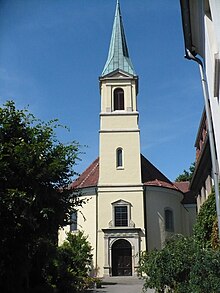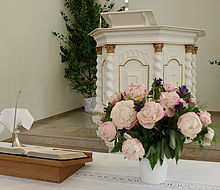Petrikirche (Minden)
The Evangelical Reformed Petrikirche Minden in Westphalia was built between 1739 and 1743 and is the church of the Reformed Community in Minden, East Westphalia, founded in 1651 . It is located in the upper old town of Minden on Ritterstraße and forms a listed ensemble together with the parish hall, the rectory, the former parish widow's house and two other houses. It is the only Evangelical Reformed church in the otherwise mainly Evangelical Lutheran parish of Minden of the Evangelical Church of Westphalia . Their parishioners come from all over the region of the old Principality of Minden .
History of the Evangelical Reformed Congregation and Church in Minden
Beginnings in Petershagen
After the Thirty Years' War , the predominantly Lutheran Minden-Ravensberg became part of the Electorate of Brandenburg through the Peace of Westphalia . The Brandenburg administration took over the previous Prince- Bishop's Castle Petershagen as the official seat of the new governor Johann von Wittgenstein. The self-reformed Great Elector Friedrich-Wilhelm founded a Reformed Congregation there in 1651 and assigned it to the Petershäger Palace Chapel, so that a separate church was available for the increasingly moving Reformed officials, soldiers and servants. He also appointed Johannes Heukeroth as a Reformed pastor, who and his successor carried the title of “court preacher”. The first baptism of the governor's daughter, Princess Louisa von Wittgenstein, is entered in the parish register for January 1652.
In Minden since 1674
The Brandenburg administration of Minden-Ravensberg moved to Minden in 1670 and so did most of the Reformed Christians. The Reformed Congregation then took over the previously vacant post office on Derenthalschen Hof, which was converted into the Reformed Church with a preacher's apartment. On September 6, 1674, this first Reformed Church in Minden was inaugurated in the presence of the Brandenburg princes Friedrich (later King Friedrich I in Prussia) and Ludwig. The community grew rapidly, especially after the Edict of Potsdam in 1685, when many Reformed religious refugees from France, the Huguenots , also came to Minden. The church soon became too small, and it was increasingly dilapidated at the beginning of the 18th century. In 1730, the community temporarily moved to the unused former Dominican Church of St. Pauli for 13 years (demolished in the 19th century).
Construction of today's church based on the French model
The congregation would have liked to take over the St. Pauli Church permanently, which was not approved by the Minden City Council. After a petition from the court preacher Saggitarius to King Friedrich-Wilhelm I , the latter approved a new building on the site of the decaying first church. The construction plan goes back to a sketch by the Minden fortress commander General Alexander von Beaufort , who fled France with his parents as a child and drew the building sketch in memory of the Huguenot church destroyed by the soldiers of King Louis XIV .
New building from 1739 to 1743
The new Reformed Church was designed as a simple oval structure based on the French model. It consists of an approximately square central section with a 17 meter high dome. On the left and right, there are annexes on the same side with slightly lower half-domes, resulting in a transverse structure about 20 meters wide and 10 meters deep. Transverse houses were added to the central building as the original sacristy and opposite as the entrance. The furnishings were mostly white and without images, with a simple baroque pulpit and a simple communion table on the south side, around which the benches were arranged in a semicircle.
Tower construction in the 19th century
After 1817 the community joined the Prussian Union , but held on to its Reformed creed. Since then, however, it has formed a joint uniate synod with the Lutheran congregations in the Minden church district. The Prussian King Friedrich Wilhelm III. gave the church the name Petrikirche and the previously "Reformed Minden Church" was now called "Evangelical Reformed Petrikirchengemeinde Minden". In 1868, for the church's 125th anniversary, new and larger windows were installed. The pulpit was rebuilt on the narrow west side and so the church had a longitudinal orientation from now on, whereby the typical character of the Reformed preaching church was abandoned, but a tower was planned for some time, which was carried out after collections throughout Prussia in 1896/97.
Changes in the 20th century
In 1913/14 the church was painted with Byzantine-style patterns according to the taste of the time. In addition, the pulpit was redesigned in the Art Nouveau style, a stone altar-like table was purchased and a pneumatic organ was installed in a large new organ gallery. The biggest change was two new windows with a crucifixion and a resurrection image. In 1954, however, these windows were bricked up again because they did not comply with the Bible's ban on images, which the Reformed took seriously. The painting was done in a simple light gray with wine-red offsets. A simple communion table made of wood replaced the stone table from 1914. In 1913 an Art Nouveau parish hall was built next to the Petrikirche.
Cross situation again since 1971
In 1971 an extensive interior renovation took place with the installation of a modern circulating heating system, which replaced the previous ovens. At the same time, the original transverse situation was restored in plain white by installing a new pulpit on the north side and the congregation sitting on chairs in a semicircle around the communion table. A large sound cover was placed over the pulpit .
Refurbishment in 2009 and reinstallation of the historic pulpit
In 2009 the Petrikirche was extensively renovated. Both inside and outside it was given a new coat of paint and new windows with the clear antique glass typical of many Reformed churches. During the renovation work, the old pulpit, which was stored behind a wall in the attic of the meeting house, was uncovered. After finding renovation drawings and following the findings of restorers and art historians, it turned out that this pulpit dates from 1674 and was one of the first furnishings of the first smaller Reformed church. In 2015, this pulpit was restored according to historical specifications and reinstalled in the church.
present
The focus of community life is the Sunday and public holiday service with simultaneous children's service. The approximately 1400 parishioners sometimes have to go very long for this, as the Reformed Petri parish is the only Reformed parish in the Minden parish. In addition to the church choir, the gospel choir, a trombone choir, a flute group and a guitar group, there is a men’s group, two women’s groups, a youth group, a senior group, a Bible discussion group and the open community meeting “Jour fixe”. The confirmation work is offered in block form once a month on Saturdays. The first year takes place earlier as "KU3" during the third school year. An environmental team is working on the criteria for the “Green Rooster” campaign. A partnership with the Reformed Community of Magdeburg has existed since 1970. The community is a member of the Reformed Union .
Web links
Individual evidence
- ↑ Hans Nordsiek: The beginnings of the ev.-ref. Petri parish Minden. Messages of the Mindener Geschichtsverein, year 65 (1993), pp. 120-125.
- ↑ Mindener Tageblatt: Minden's first parish hall is 100 years old Mindener Tageblatt of October 17, 2013, accessed on October 17, 2013
- ^ Foundation KIBA, Foundation for the Preservation of Church Monuments in Germany, Petrikirche Minden project , accessed on October 13, 2014.
- ↑ Glißmann, Oliver, Make new out of old. The redesign of the baroque pulpit of Minden Petrikirche, (DE-588) 137246927
- ↑ Homepage of the Minden church district ( Memento of the original from January 23, 2013 in the Internet Archive ) Info: The archive link was automatically inserted and not yet checked. Please check the original and archive link according to the instructions and then remove this notice. , accessed October 5, 2012.
Coordinates: 52 ° 17 ′ 13 ″ N , 8 ° 54 ′ 45 ″ E


